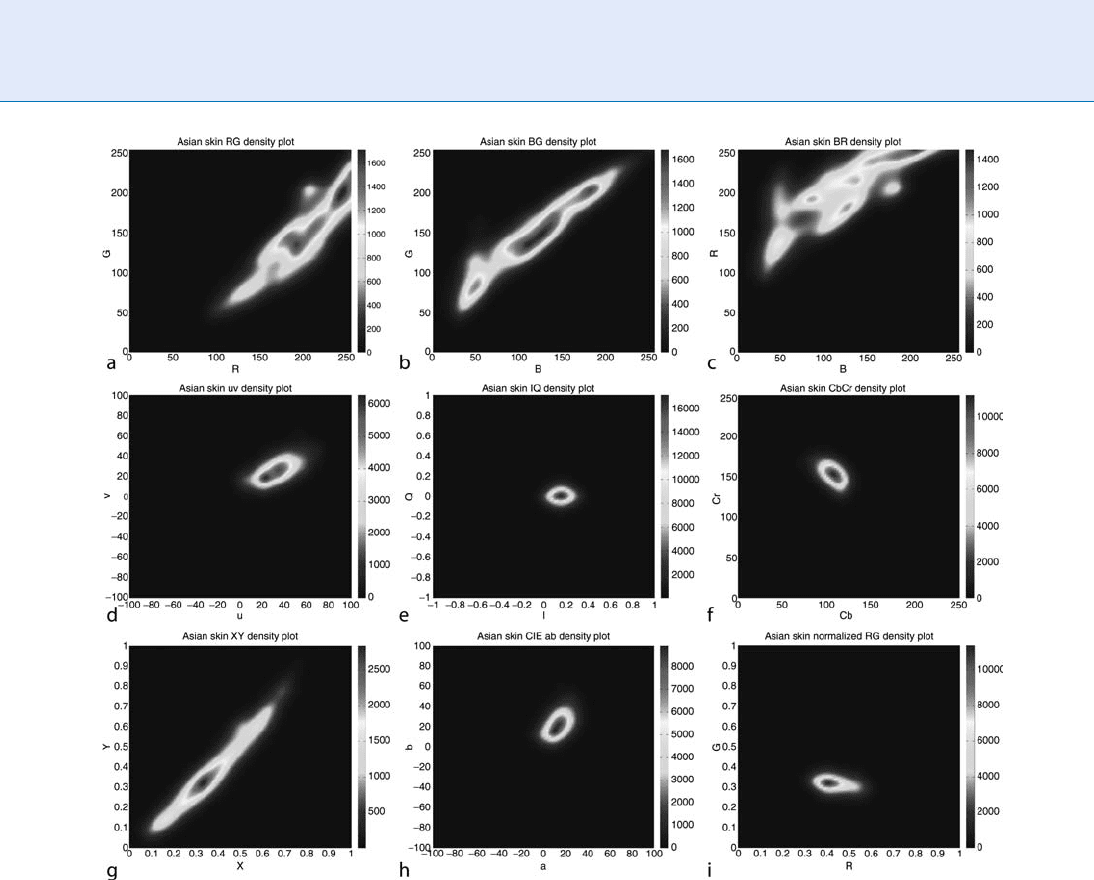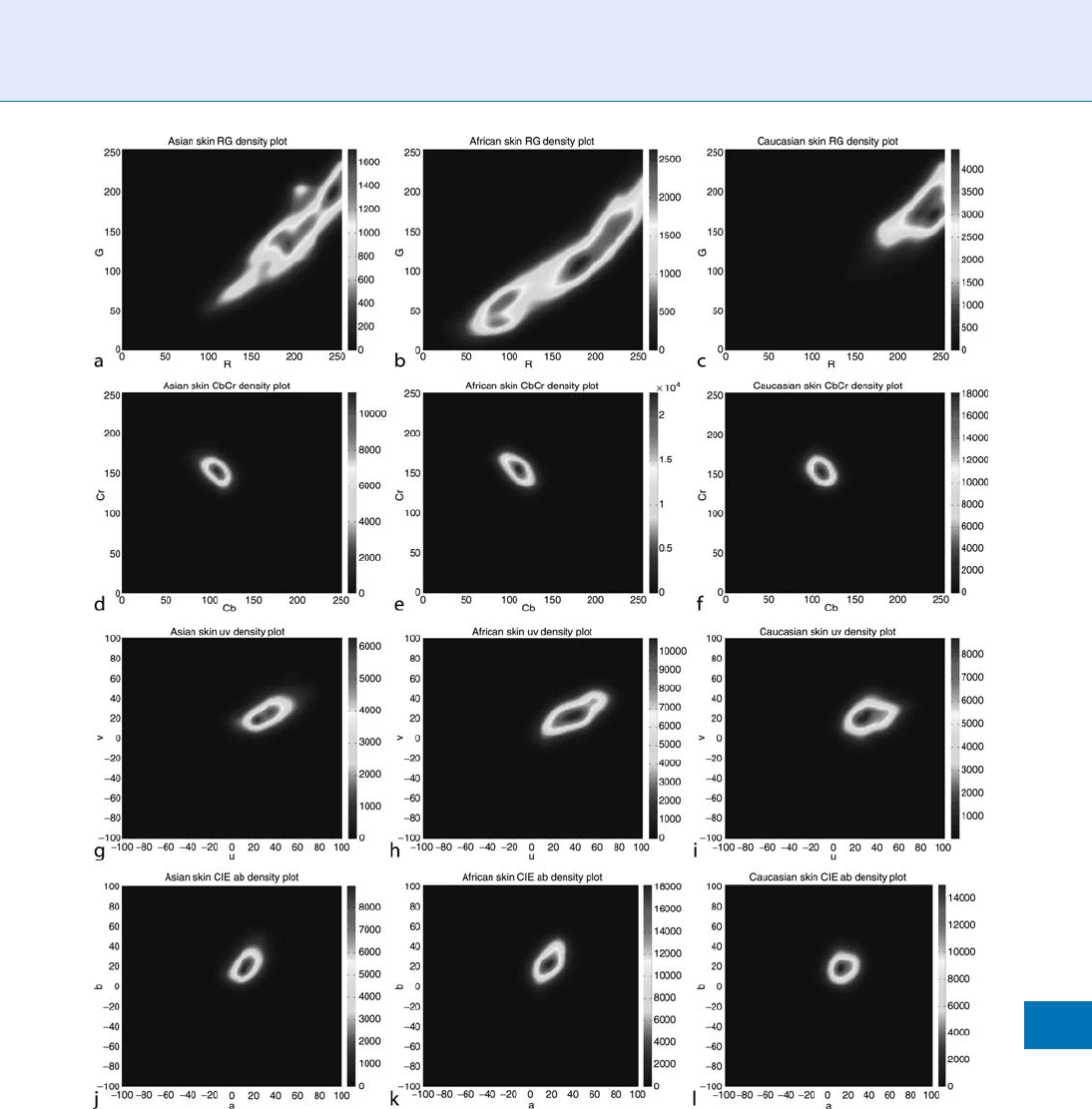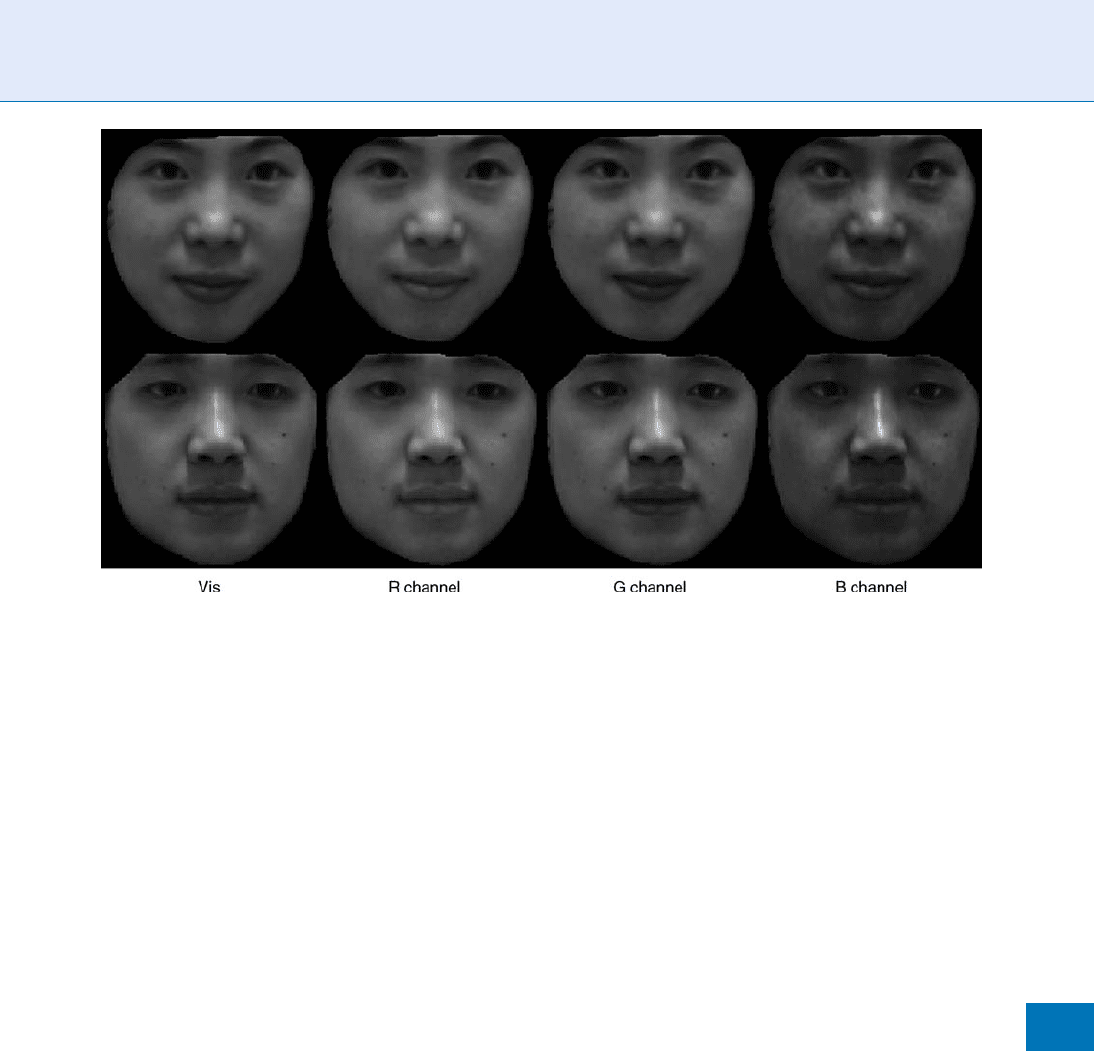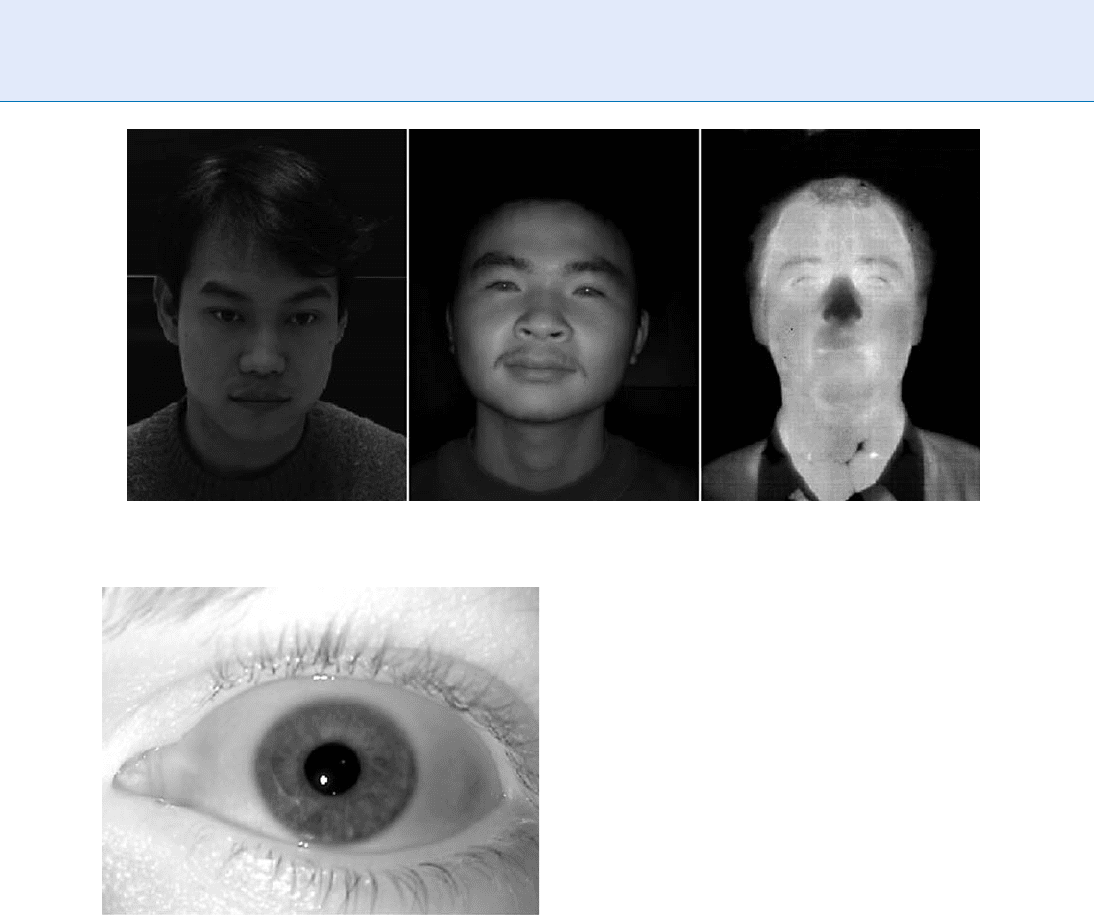Li S.Z., Jain A.K. (eds.) Encyclopedia of Biometrics
Подождите немного. Документ загружается.


G, and B components are highly correlated. The lumi-
nance of a given RGB pixel is a linear combination of
the R, G, and B values. Therefore, changing the lumi-
nance of a given skin patch affects all the R, G, and B
components. In other words, the location of a given
skin patch in the RGB color cube will change based on
the intensity of the illumination under which such
patch was imaged! This results in a very stretched
skin color cluster in the RGB color cube. This can be
noticed in the first row of Fig. 1 where skin patches
from images of Asian people taken at arbitrary random
illumination are plotted in the RGB space. The skin
color cluster is extended in the space to reflect the
different illumination intensities in the patches. Simi-
larly, the skin color clusters for patches from different
races will be located at different locations in the RGB
color space. This can be seen in the first row of Fig. 2.
Despite these fundamental limitations, RGB is exten-
sively used in skin detection literature because of its
simplicity. For exampl e, RGB is used by Rehg and
Jones [8] and yields quite a satisfying performance.
TV Color Spaces and Skin Detection: A different
class of color spaces is the orthogonal one used in TV
tansmission. This includes YUV, YIQ, and YC
b
C
r
. YIQ
is used in NTSC TV broadcasting while YC
b
C
r
is used
in JPEG image compression and MPEG video com-
pression. One advantage of using these color spaces is
that most video media are already encoded using these
color spaces. Transforming from RGB into any of these
spaces is a straight forward linear transformation [5].
All these color spaces separate the illumination channel
(Y) from two orthogo nal chrominance channels (UV,
IQ, C
b
C
r
). Therefore, unlike RGB, the location of the
skin color in the chrominance channels will not be
Skin Detection. Figure 1 Density plots of Asian skin in different color spaces.
1220
S
Skin Detection

affected by changing the intensi ty of the illumina-
tion. In the chrominance channels the skin color is
typically located as a compact cluster with an elliptical
shape. This can be seen in Figs.1d–f. This facilitates
building skin detectors that are invariant to illu-
mination intensity and that use simple classifiers. The
density of the skin color over the chrominance chan-
nels can be easily approximated using a multivariate
Gaussian distribution. Moreover, the skin colors of
different races almost colocate in the chrominance
channels. This can be seen in the second and third
rows of Fig. 2. Therefore, using such color spaces
results in skin detectors which are invariant to
human race. The simplicity of the transformation
and the invariant properties made such spaces widely
used in skin detection applications [1, 2, 9–11, 14].
Skin Detection. Figure 2 Density plots of Asian, African and Caucasian skin in different color spaces.
Skin Detection
S
1221
S

Perceptual Color Spaces and Skin Detection: Percep-
tual color spaces, such as HSI , HSV∕HSB, and HSL
(HLS), have also been popular in skin detection. These
color spaces separate three components: the hue (H),
the saturation (S), and the brightness (I,V or L). Essen-
tially, HSV-type color spaces are deformations of the
RGB color cube and they can be mapped from the
RGB space v ia a nonlinear transformation. One of
the advantages of these color spaces in skin detection
is that they allow users to intuitively specify the bound-
ary of the skin color class in terms of the hue and
saturation. As I, V or L give the brightness information,
they are often dropped to reduce illumination depen-
dency of skin color. These spaces have been used
by Shin et al. [11] and Albiol et al. [2].
Colorimetric Color Spaces and Skin Detection:
Separating the chromaticity from the brightness is
also achieved in Colorimetric color spaces, such as
CIE-XYZ, CIE-xy, CIE-Lab defined by the Interna-
tional Commission on Illumination (Commission
Internationale d’E
`
clairage – CIE). CIE-XYZ color
space is one of the first mathematically defined color
spaces (defined in 1920s). It is based on extensive
measurements of human visual perception, and serves
as a foundation of many other colorimetric spaces.
CIE-XYZ can be achieved through a linear coordinate
transformation of the RGB color space. The Y compo-
nent corresponds to the lightness of the color (the
luminance). The chromaticity values (x , y) can be
achieved by central projection into the plane XþYþ
Z¼1 and then projecting into the XY plane. For details
see [5]. The result is the well-known horse-shaped
CIE-xy chromaticity diagram defining the hue and
saturation of any color. One of the disadvantages of
the XYZ and the xy color spaces is that the color
differences are not perceived equally in di fferent
regions of the color space. In contrast, the CIE
-Lab
separates a luminance variable L from two perceptually
uniform chromaticity variables (a, b). Fig.1h shows
the skin color density for Asian skin in the a,b chro-
maticity space. Figure 2 (last row) shows the skin
color density for different races in the a,b space. Despite
the many advantages of such color spaces, they are
rarely used in skin detection. This is mainly because the
transformation from RGB is more computationally
expensive than other spaces. CIE-XYZ color space
was used by Shin et al. [11] in comparison with other
color spaces. The chrominance xy plane was used by
Lee and Yoo [9].
Skin Classifiers
Avariety of classification techniques has been used in the
literature for the task of skin classification. A skin classi-
fier is a one-class classifier that defines a decision bound-
ary of the skin color class in a feature space. The feature
space in the context of skin detection is simply the color
space chosen. Any pixel which color falls inside the skin
color class boundary is labeled as skin. Therefore, the
choice of the skin classifier is directly induced by the
shape of the skin class in the color space chosen by a skin
detector. The more compact and regularly shaped the
skin color class, the more simple the classifier.
The simplest way to decide whether a pixel is
skin color or not is to explicitly define a boundary.
Brand and Mason [4] constructed a simple one-di-
mensional skin classifier: a pixel is labeled as a skin if
the ratio between its R and G channels is between a lower
and an upper bound. They also experimented with one-
dimensional threshold on IQ plane of YIQ space where
the ‘‘I’’ value is used for thresholding. Other methods
explicitly define the skin color class boundary in a two-
dimensional color space using elliptical boundary models
[9]. The parameters of the elliptical boundary can be
estimated from the skin database at the raining phase.
Baysian Approach for Skin Detection: Skin classifica-
tion can be defined probabilistically as: given a pixel with
color c what is the probability of it being skin pixel
P(skinjc). Once this probability is computed, the pixel
is labeled as a skin pixel if such probability is larger
than a threshold and nonskin otherwise. Obviously
such probabilities cannot be computed for every pos-
sible color (e.g., in 24 bit RGB, there are 256
3
colors).
Fortunately, using Bayes rule, this can be rewritten as
PðskinjcÞ¼
Pðcjskin ÞPðskinÞ
Pðcjskin ÞPðskinÞþPðcjnotskinÞPðnotskinÞ
Bayes rule defines the posterior probability of a pixel
being skin given its color (P(skinjc)) in terms of the
likelihood of observing such color given the skin class
(P(cjskin)) and the prior probability of the skin class
P(skin). The prior probability measures our guess about
a random pixel being a skin without observing its color.
The denominator in the Bayes rule is the total proba-
bility of observing the color c, a factor that does not
affect the decision whether a pixel ought to be labeled as
skin or nonskin. Given Bayes rule, the skin classi-
fication reduces to computing the likelihood term, i.e.,
P(cjskin). Given a database of skin-colored pixels, the
1222
S
Skin Detection

probability density function (pdf) of P(cjskin) can be
estimated. Several approaches have been introduced
to compute this pdf including the use of histograms
[8], the use of a single Gaussian model, or a Mixture of
Gaussians model [12] to approximate such pdf.
The skin classifier can also be posed as a two-class
problem. From Bayes rule, this results in computing the
likelihood ratio of observing a given color given a skin
class versus a nonskin class, i.e., P(cjskin)∕P(cjnotskin).
Such a ratio can then be thresholded to decide whether
a pixel is a skin or nonskin pixel. Besides modeling the
likelihood of an observed color given the skin class, the
complementary class needs to be models. That is,
modeling the probability density function of nonskin
pixels P(cjnotskin). Rehg and Jones [8] approximated
such pdfs using 3D histograms in the RGB space based
on a large database of skin and nonskin images.
Skin Detection Applications and
Examples
Human face localization and detection is the first step
in obtaining face biometrics. Skin color is a distin-
guishing feature of human faces. In a controlled back-
ground environment, skin detection can be sufficient
to locate faces in images. As color processing is much
faster than processing other facial features, it can be
used as a preliminary process for other face detection
techniques [10]. Skin detec tion has also been used to
locate body limbs, such as hands, as a part of hand
segmentation and tracking systems, e.g., [7 ].
Forsyth and Fleck [6] demonstrated that skin filter
can be used as part of the detection process of images
with naked or scantily dressed people. Their technique
has three steps. First, a skin filter, based on color and
texture, was used to select images with large areas of
skin-colored pixels. Then, the output is fed into a
geometric filter which identifies the skin-colored regions
with cylindrical shapes. Those skin-colored cylinders
are grouped into possible human limbs and connected
groups of limbs. Images containing sufficiently large
skin-colored groups of possible limbs are then reported
as containing naked people.
Zheng et al. [14] presented an adaptive skin detec-
tor for detecting naked pictures on the internet. Their
technique applies a face detector on the picture first to
find the skin color. They argued that as skin color highly
depends on illumination and the race of the person, it is
more appropriate to get the skin color from the face of
the person in the image. Using the skin color and the
property of the texture from the detected face region,
the rest of skin pixels in the image can be detected.
Skin Detection Performance
Regardless of the choice of the color space and the
classification method, most published research on
skin detection reports about 95% true detection while
the false detection rates varies from 15 to 30%.
Summary
Skin detection in color images and videos is a very
efficient way to locate skin-colored pixels, which might
indicate the existence of human faces and hands. How-
ever, many objects in the real world have skin-tone
colors, such as some kinds of leather, sand, wood, fur,
etc., which might be mistakenly detected by a skin
detector. Therefore, skin detection can be very useful
in finding human faces and hands in controlled envir-
onments where the background is guaranteed not to
contain skin-tone colors. Since skin detection depends
on locating skin-colored pixels, its use is limited to color
images, i.e., it is not useful with gray-scale, infrared, or
other types of image modalities that do not contain
color information. There has been extensive research
on finding human faces in images and videos using
other cues such as finding local facial features or finding
holistic facial templates [13]. Skin detection can also be
used as an efficient preprocessing filter to find poten-
tial skin regions in color images prior to applying more
computationally expensive face or hand detectors.
Related Entries
▶ Face Localization
▶ Face Recognition, Over view
▶ Hand Recognition
References
1. Abdel-Mottaleb, M., Elgammal, A.: Face detection in complex
environments from color lmages. In: Proceedings of the Interna-
tional Conference on Image Processing (ICIP), pp. 622–626 (1999)
Skin Detection
S
1223
S

2. Albiol, A., Torres, L., Delp, E.: Optimum color spaces for skin
detection. In: Proceedings of the International Conference on
Image Processing (ICIP), pp. I: 122–124 (2001)
3. Bernhard Fink, K.G., Matts, P.J., Visible skin color distri-
bution plays a role in the perception of age, attractiveness,
and health in female faces. Evol. Hum. Behav. 27(6), 433–442
(2006)
4. Brand, J., Mason, J.: A comparative assessment of three
approaches to pixellevel human skin-detection 1, 1056–1059
(2000)
5. Burger, W., Burge, M.: Digital Image Processing, an Algorithmic
Introduction Using Java. Springer, Berlin (2008)
6. Fleck, M.M., Forsyth, D.A., Bregler, C.: Finding naked people.
In: Proceedings of the European Conference on Computer
Vision (ECCV), pp. 593–602 (1996)
7. Imagawa, K., Lu, S., Igi, S.: Color-based hands tracking system
for sign language recognition. In: FG ’98: Proceedings of the
Third International Conference on Face and Gesture Recogni-
tion, p. 462. IEEE Computer Society, Washington, DC, USA
(1998)
8. Jones, M.J., Rehg, J.M.: Statistical color models with appli-
cation to skin detection. Int. J. Comput. Vision (IJCV)
46(1), 81–96 (2002). URL citeseer.ist.psu.edu/jones99statistical.
html
9. Lee, Y., Yoo, S.I.: An elliptical boundary model for skin color
detection. In: Proceedings of the International Conference on
Imaging Science, Systems, and Technology (2002)
10. Senior, A., Hsu, R.L., Mottaleb, M.A., Jain, A.K.: Face detection
in color images. IEEE Trans. Pattern Analy. Mach. Intell.
(PAMI) 24(5), 696–706 (2002). DOI http://dx.doi.org/10.1109/
34.1000242
11. Shin, M.C., Chang, K.I., Tsap, L.V.: Does colorspace transforma-
tion make any difference on skin detection? In: WACV ’02:
Proceedings of the Sixth IEEE Workshop on Applications of
Computer Vision, p. 275. IEEE Computer Society, Washington,
DC, USA (2002)
12. Yang, M., Ahuja, N.: Gaussian mixture model for human skin
color and its application in image and video databases.
In: Proceedings of the SPIE: Conference on Storage and
Retrieval for Image and Video Databases (SPIE 99), vol. 3656,
pp. 458–466 (1999)
13. Yang, M., Kriegman, D., Ahuja, N.: Detecting faces in images:
A sur vey. IEEE Trans. Pattern Analy. Mach. Intell. (PAMI) 24(1),
34–58 (2002)
14. Zheng, Q.F., Zhang, M.J., Wang, W.Q.: A hybrid approach to
detect adult web images. In: PCM (2), pp. 609–616 (2004)
Skin Print
▶ Skin Texture
Skin Spectroscopy
DONG YI,WEILONG YANG,STAN Z. LI
Center for Biometrics and Security Research &
National Laboratory of Pattern Recognition, Institute
of Automation, Chinese Academy of Sciences,
Beijing, China
Synonyms
Spectral analysis of skin
Definition
Skin spectroscopy is the study of interaction between
radiation and human skin, as a function of wavelength.
Human skin has a complicated multilayered structure
and each layer is composed of different chemical sub-
stance. The determination of the interaction can be
made by measuring the reflectance property of skin.
Introduction
The interaction between electromagnetic radiation and
matter at various wavelengths can be used to reveal the
structure of matter. The study of this interaction is
named as spectroscopy. Since the composition of the
object has different response under different radiation,
when the surface of an object is illuminated by the
radiation with different wavelength, the reflectance
will vary as well.
The study of skin spectroscopy originated in the
field of photobiology, which has tens of years history.
From the reflectance of skin under the radiation of
some wavelength, clinicians can obtain the composi-
tion of skin and observe the changes in skin or blood.
In [1], Anderson et al. established an effective optical
model for each layer of human skin by Kulberka-Munk
approach. The work developed a quantitative, general
model for the radiation transfer in the human skin.
Based on this model, the optical paramet ers of each
skin layer can be acquired.
Skin is a good basis for establishing the biometric
identity, because everyone has unique skin properties
in terms of color, appearance, texture, and inner struc-
ture. Skin spectroscopy provides an efficient way to
1224
S
Skin Print

describe these properties of skin under the radiation of
different wavelengths. Measurements of skin optics
under radiations of multiple wavelengths can provide
more information than using a single wavelength,
which can enhance the performance of biometric
system. In addition to the traditional visible light im-
aging, near-infrared and thermal-infrared imaging
have been applied in the biometric system.
Spectral Bands
Skin spectroscopy is focused on the interaction be-
tween electromagnetic wave and human skin. From
long to short wavelength, electromagnetic wave can
be divided into several categories: radio wave, infrared
(IR), visible light (VIS), ultraviolet (UV), x-ray,and
gamma ray. Radio wave is usually passed around the
human body with no interaction with the human skin,
due to its long wavelength and low energy. X-ray and
gamma ray can easily penetrate human skin to damage
cells in tissue. Although ultraviolet is widely used in
photo-medicine for disease diagnosis, high-intensity
ultraviolet can cause skin suntan, burn, or even skin
cancer. For noninvasive biometric applications, VIS
and IR are two main bands that have been used practi-
cally. The spect rum of visible light is usually divided
into three channels: red, green, and blue. The infrared
portion of electromagnetic wave can be divided into
four spectral regions: near infrared (NIR), short-wave
infrared, thermal infrared (TIR), and far infrared
(FIR). Fig. 1 illustrates UV, VIS, and IR bands in
different wavelength.
Human Skin Structure
Skin is the largest organ of the human body, which
covers the whole body and protects the internal tissue
from outside damage. From one’s skin, we can access
his mood, health condition, and attractiveness. Human
skin has a complex, multilayered structure and chemi-
cal composition. Generally, from outside to inside,
human skin is composed of the following layers:
The epidermis, which is the exterior layer of skin. It
does not contain blood vessels. The main type of
cells in the epidermis are keratinocytes, melano-
cytes, Langerhans cells, and Merkels cells. Among
these cells, melanocytes are the most important
cells for skin spectroscopy, because they can syn-
thesize melanin.
The dermis, which is the layer of skin beneath the
epidermis. It contains hair follicles, sweat glands,
sebaceous glands, apocrine glands, lymphatic ves-
sels, blood vessels, and nerve endings. The blood
vessels provide nutrition for the epidermis and the
dermis. Nerve endings can provide the sense of
touch and heat.
The subcutaneous tissue, which has no evident
boundary with the dermis, can isolate body from
heat and store energy. The main constituent of
subcutaneous tissue is adipose.
Human Skin Optics
The radiation first interacts with the surface of the
skin and then penetrates inside, but it usually cannot
reach the subcutaneous tissue. Thus, the skin sur-
face, the epidermis, and the dermi s are three main
aspects that been studied in skin spectroscopy. In the
following sections, the optical properties of interface
between air and the stratum corneum, the epidermis,
and the dermis will be described. The optics of skin
is dependent on the wavelength and the dose of
the incident light. Due to the high energy, x-ray
and gamma ray can cause chemical reactions with
the cells of the skin and the body, which is called
‘‘radiolysis’’. Here, only the spectrum from 0.25 to
3 mm (including UV, VIS and IR) is discussed ,
because the other spectra do not have much signifi-
cance for biometrics.
Skin Spectroscopy. Figure 1 The electromagnetic wave radiation spectrum bands.
Skin Spectroscopy
S
1225
S

A typical process of interaction between radiation
and the skin is illustrated in Fig. 2. Under the incident
radiation, a small fraction of radiation is reflected by
the interface between air and the stratum corneum.
Generally, the reflectance is always between 4% and
7% over the entire spectrum from 0.25 to 3 mm, for all
kinds of skin (white, black, etc.). Since the surface of the
stratum corneum is not flat and smooth, the reflectance
from skin is not specular except those reflected by oil.
The remaining 93–96% of the incident radiation pene-
trates into the skin and will be absorbed or scattered.
In the UV band, there are many cells and chemical
constituents in the epidermis, affecting the transmit-
tance and the remittance of the radiation. For example,
aromatic amino acids tryptophan and tyrosine are
with a minimum transmittance near 0.275 mm; nucleic
acids are with an absorption maximum near 0.26mm;
and numerous small aromatic molecules are with an
absorption maximum at 0.277 mm, and so on. The
content and distribution of melanin play an important
role in determining the optical properties of epidermis.
In the VIS band, melanin is the only pigment
affecting the transmittance of epidermis. Shorter wave-
lengths, such as blue light, are hig hly absorbed by
certain tissue components such as melanin and blood
compared with longer wavelengths. In addition, the
optical scattering increases as the wavelength gets
shorter in this spectral range. For these reasons, longer
wavelengths (red) penetrate the tissue deeper than
shorter wavelengths. This phenomenon is illustrated
in Fig. 3, in which the R channel is shown to be the
smoothest channel and B channel contains most details.
The skin color (VIS spectrum) is affected by
the type and quantity of me lanin in the epidermis.
This results in various skin colors from white to
brown and black, although the structure of human
skin is similar across different races. The absorption
of melanin decreases monotonously from the short
wavelength of 0.25 mm in the UV band (through the
VIS band wavelength) to the long wavelength of 1.1
mm in the NIR band. Beyond 1.1mm, the absorption of
melanin is negligible and both the transmittance and
remittance of skin are uncorrelated with melanin. TIR
of wavelength between 2.4 and 15 mm is often used
passively to determine the temperature of skin.
The dermis has a significantly different structure
and composition with epidermis, which causes their
different optical properties. Maybe, because the dermis
is deeper than epidermis, fewer studies have concen-
trated on dermal optics. In the dermis, scattering holds
the dominant position. Many observations show that
the transmittance and remittance are close to 100%
across the spectrum from 0.3 to 2.4 mm, indicating
that very little radiation is absorbed there. Light of
longer wavelengths can penetrate the dermis deeper
than shorter wavelengths.
Skin Spectroscopy. Figure 2 The general model of interaction between radiation and skin.
1226
S
Skin Spectroscopy

Biometrics Applications
From the foregoing discussion, we can find out two
important properties of skin spectroscopy: uniqueness
and diversity, which make the skin spectroscopy be-
come a valuable tool for the biometric technology. The
uniqueness is that everyone has his unique spectro-
scopic properties of skin, which provides a discrimina-
tive feature for the biometric systems. The diversity is
that the properties of different skin parts are diverse
under the radiation of different wavelengths, which
provides abundant features to describe skin.
Due to the nutritious texture information, face,
fingerprint, and palmprint are the three main parts of
skin used in biometric system s, which are called ‘‘mo-
dality’’ in biometrics. In addition, their physical for-
mation is stable and all of them can be easily imaged by
the optical sensors with different wavelengths. Then,
the application of skin spectroscopy in the biome tric
systems is introduced in the following section.
In terms of the spectrum of radiation, VIS, NIR, and
TIR are the three common bands used widely in face
recognition. Fig. 4 shows VIS, NIR, and TIR
(thermogram) face images. Apparently, TIR face image
contains less texture information than VIS and NIR
images. The most conv entional face recognition is based
on face images captured by common VIS camera. More
recently, techniques based on NIR [2, 3] and TIR [4, 5]
images are introduced to overcome problems arising
from changes in ambient illumination. Notably, facial
thermogram is not based on skin spectroscopy, which
shows the active TIR radiation of live human skin.
In fingerprint recognition, there are three common
data acquiring devices: optical, ultrasonic, and capaci-
tance. The first one belongs to spectroscopy-based
methods. Optical imaging devices usually capture a
digital image of fingerprint, using VIS light. One dis-
advantage of this type of sensor is that the imaging
capacity is affected by the skin quality of the finger.
Novel sensing techniques such as multispectral imag-
ing [7, 8] have been developed to overcome this prob-
lem. The principle of the ultrasonic device is very
similar to that of skin spectroscopy-based methods
while just using ultrasonic instead of electromagnetic
wave. Ultrasonic sensors use very high-frequency
sound waves to penetrate the epidermal layer of the
skin. Since the dermal skin layer exhibits the same
characteristic pattern of the fingerprint, the reflected
wave measurements can be used to form an image of
the fingerprint. This eliminates the need for clean,
undamaged epidermal skin and a clean sensing surface.
For palmprint biometric, a large region of palm
supplies plenty of line patterns that can be easily cap-
tured by a low-resolution imaging device. Palmprint
images are often captured by an active VIS lighting
imaging device in a semiclosed environment [9].
Skin Spectroscopy. Figure 3 Two face images in VIS and their RGB channels.
Skin Spectroscopy
S
1227
S

Strictly, the iris is not the skin, but it has a rich texture
like skin that can be used to distinguish different people.
Its complex patterns co ntain many distinctive features.
NIR wa v elengths can penetrate the iris as deep as they
penetrate the skin. Hence, NIR is used for clear and
unobtrusive imaging at a distance of up to 1m further.
Moreo v er, under active NIR light, even darkly pigmented
irises reveal rich features. Fig. 5 is a NIR iris image that
presents complex iris texture pattern.
Moreover, compared with these single-modal sys-
tems described earlier, hybrid biometric systems can
achieve better performance by fusing some modalities
or spectrum, for example, face+fingerprint [10],
face+iris [11], face+palmprint [12], multispectral
NIR face [2] etc.
Summary
From the perspective of skin spectroscopy, the human
skin has its reflectance and absorption character-
istics as a function of wavelength of illumination.
Since the composition of skin across people have
significant difference, skin spectroscopy has been
widely used in biometrics, in which many parts of
skin with nutritious texture (face, fingerprint, palm-
print, and other modalities) are often chosen as
objects of study. For every modality, one or many
appropriate bands can be chosen according to the
skin spectroscopy. By fusing some modalities or spec-
trum, lots of hybrid biometrics have been generated.
Generally, compared with single biometric, multi-
spectral or multimodal features of skin can lead to
more effective bio metric systems. More applications
of skin spectroscopy to biometric technologies can
be foreseen.
Related Entries
▶ Face Recognition
▶ Fingerprint Recognition
▶ Multibiometrics
▶ Multi-Spectral Biometrics
▶ Near Infrared
▶ Near Infrared Face Recognition
▶ Palmprint Recognition
Skin Spectroscopy. Figure 4 VIS, NIR and TIR face images. The TIR image is from the Equinox database [6].
Skin Spectroscopy. Figure 5 A NIR iris image.
1228
S
Skin Spectroscopy

References
1. Anderson, R.R., Parrish, J.A.: The optics of human skin. J. Invest.
Dermatol. 77, 13–19 (1981)
2. Pan, Z.H., Healey, G., Prasad, M., Tromberg, B.: Face recognition
in hyperspectral images. IEEE Trans. Pattern Anal. Mach. Intell.
25(12), 1552–1560 (2003)
3. Li, S.Z., Chu, R., Liao, S., Zhang., L.: Illumination invariant face
recognition using near-infrared images. IEEE Trans. Pattern
Anal. Mach. Intell. 26(Special issu e on Biometrics: Progress
and Directions) (2007)
4. Selinger, A., Socolinsky, D.A.: Face recognition in the dark. In:
Proceedings of IEEE Computer Society Conference on Computer
Vision and Pattern Recognition Workshops, Washington, DC,
USA, pp. 129–129 (2004)
5. Chen, X., Flynn, P.J., Bowyer, K.W.: Infra-red and visible-light
face recognition. Comput. Vis. Image Underst. 99, 332–358
(2005)
6. Miezianko, R.: Terravic Research Infrared Database. http://www.
terravic.com/research/index.htm (Accessed June 17, 2008)
7. Rowe, R.K., Corcoran, S.P., Nixon, K.: Biometric identity
determination using skin spectroscopy. Tech. rep., http://www.
lumidigm.com (2004)
8. Jain, A.K., Flynn, P., Ross, A.A. (eds.): Handbook of Biometrics.
Springer (2008)
9. Zhang, D., Kong, W.K., You, J., Wong, M.: Online palmprint
identification. IEEE Trans. Pattern Anal. Mach. Intell. 25(9),
1041–1050 (2003)
10. Hong, L., Jain, A.: Integrating faces and fingerprints for personal
identification. IEEE Trans. Pattern Anal. Mach. Intell
11. Wang, Y., Tan, T., Jain, A.K.: Combining face and iris for identity
verification. In: Proceedings of International Conference on
Audio- and Video-based Biometric Person Authentication.
Guildford, UK (2003)
12. Gao, Y., M.Maggs: Feature-level fusion in personal identifica-
tion. In: Proceedings of IEEE Computer Society Conference
on Computer Vision and Pattern Recognition. San Diego, CA,
USA (2005)
Skin Texture
XIANGXIN ZHU,ZHEN LEI,STAN Z. LI
Biometrics and Security Research & National
Laboratory of Pattern Recognition, Institute of
Automation, Chinese Academy of Sciences, Beijing,
China
Synonyms
Skin Print
Definition
Generaltly, skin texture is the surface texture pattern of
any part of human body with bare skin (e.g., face,
hand, and palm). In the context of biometrics, this
term commonly refers to the technologies and meth-
ods of face recognition using highly detailed facial skin
texture in high-resolution images.
Introduction
Since the success of local features in face recognition in
late 1990s, researchers have been seeking for more de-
tailed representations of human faces. Skin texture con-
tains plentiful detailed local information, and therefore
starts to attract research attention [1]. A person’s skin
texture pattern is, to some extent, a uni que physical
trait and is distinguishable from those of others, and
thus can be used for biometric identification.
The primary difference between conventional face
recognition method s and skin texture methods is
the resolution of facial images used. Typically, in con-
ventional face recognition methods, the faces are scaled
to 30–60 or so pixels between the centers of eyes. For
skin texture methods, the inter-eye distance should be
at least 90 pixels to obtain reasonable performance.
With much higher
▶ image resolution, more sophisti-
cated face recognition algorithms could possibly be
proposed to yield better recognition accuracy.
However, with the increased facial image resolu-
tion, higher quality image capture devices, and more
computing resources are needed for acquiring and
processing the facial images, both expensive. In the
1990s, those were the main obstac les in the applica-
tions and developments of skin texture methods. Since
2000, high quality digital cameras and webcams are
becoming more affordable, and the processing speed of
personal computers is ten times faster than it was a
decade ago with much lower price. Those have cata-
lyzed the advance of skin texture technology.
Skin Texture Based Methods
The first work to create the skin texture face recogni-
tion algorithms was pioneered by Delean Vision
around 2001 [2]. The Delean method uses a probabi-
listic image analysis method for skin texture matching.
Skin Texture
S
1229
S
